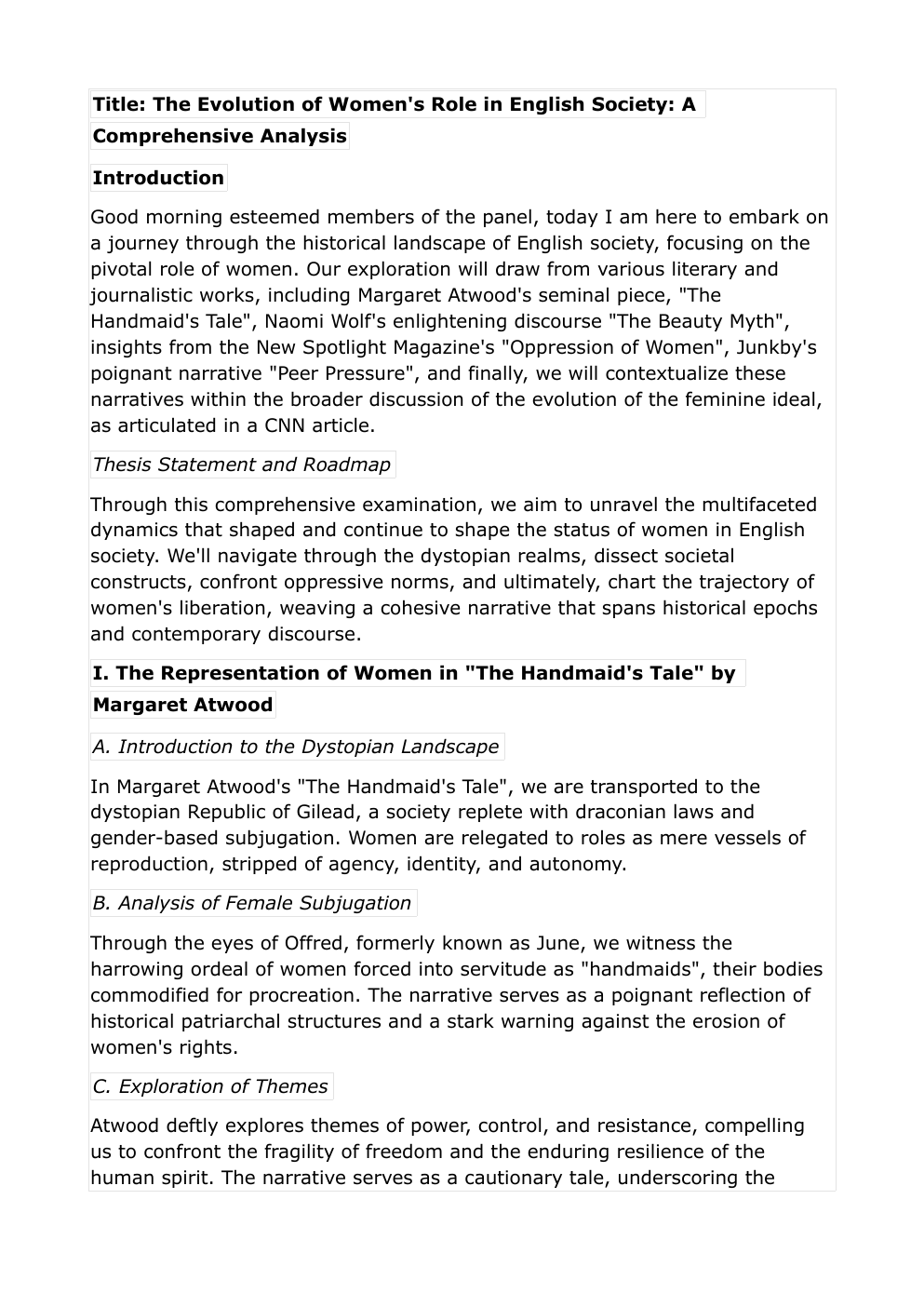ORAL LLCE Title: The Evolution of Women's Role in English Society: A Comprehensive Analysis
Publié le 22/05/2024
Extrait du document
«
Title: The Evolution of Women's Role in English Society: A
Comprehensive Analysis
Introduction
Good morning esteemed members of the panel, today I am here to embark on
a journey through the historical landscape of English society, focusing on the
pivotal role of women.
Our exploration will draw from various literary and
journalistic works, including Margaret Atwood's seminal piece, "The
Handmaid's Tale", Naomi Wolf's enlightening discourse "The Beauty Myth",
insights from the New Spotlight Magazine's "Oppression of Women", Junkby's
poignant narrative "Peer Pressure", and finally, we will contextualize these
narratives within the broader discussion of the evolution of the feminine ideal,
as articulated in a CNN article.
Thesis Statement and Roadmap
Through this comprehensive examination, we aim to unravel the multifaceted
dynamics that shaped and continue to shape the status of women in English
society.
We'll navigate through the dystopian realms, dissect societal
constructs, confront oppressive norms, and ultimately, chart the trajectory of
women's liberation, weaving a cohesive narrative that spans historical epochs
and contemporary discourse.
I.
The Representation of Women in "The Handmaid's Tale" by
Margaret Atwood
A.
Introduction to the Dystopian Landscape
In Margaret Atwood's "The Handmaid's Tale", we are transported to the
dystopian Republic of Gilead, a society replete with draconian laws and
gender-based subjugation.
Women are relegated to roles as mere vessels of
reproduction, stripped of agency, identity, and autonomy.
B.
Analysis of Female Subjugation
Through the eyes of Offred, formerly known as June, we witness the
harrowing ordeal of women forced into servitude as "handmaids", their bodies
commodified for procreation.
The narrative serves as a poignant reflection of
historical patriarchal structures and a stark warning against the erosion of
women's rights.
C.
Exploration of Themes
Atwood deftly explores themes of power, control, and resistance, compelling
us to confront the fragility of freedom and the enduring resilience of the
human spirit.
The narrative serves as a cautionary tale, underscoring the
precariousness of women's rights in the face of authoritarian regimes and
societal regression.
II.
Deconstructing the "Beauty Myth" in Naomi Wolf's Work
A.
Unpacking Societal Constructs
Naomi Wolf's "The Beauty Myth" unveils the insidious nature of societal beauty
standards, illuminating how they serve as tools of oppression, constraining
women within narrow confines of acceptability.
B.
Analysis of Normative Pressures
Wolf elucidates how the relentless pursuit of an unattainable ideal perpetuates
cycles of self-doubt, insecurity, and conformity.
Women are bombarded with
unrealistic expectations, leading to pervasive feelings of inadequacy and selfloathing.
C.
Implications for Women's Autonomy
The "beauty myth" not only commodifies women's bodies but also undermines
their autonomy, relegating them to passive objects of desire rather than active
participants in society.
Wolf's work underscores the urgent need to challenge
and deconstruct these harmful narratives to foster a more inclusive and
equitable society.
III.
Unveiling the Layers of Oppression in the New Spotlight
Magazine's "Oppression of Women"
A.
Examination of Systemic Barriers
The New Spotlight Magazine's exposé on the "Oppression of Women" provides
a comprehensive analysis of the multifaceted forms of discrimination and
injustice faced by women in English society.
From wage disparities to
institutionalized sexism, the article lays bare the systemic barriers that hinder
women's progress and equality.
B.
Intersectional Lens
Moreover, the article adopts an intersectional lens, recognizing the intersecting....
»
↓↓↓ APERÇU DU DOCUMENT ↓↓↓
Liens utiles
- Oral LLCE Dossier Spécialité English
- Exemple d'un sujet d'oral de bac de LLCE
- oral llce
- oral dossier llce anglais
- Grand oral llce: Est-il possible de déconstruire les préjugés de notre société afin de se construire soi-même ?


